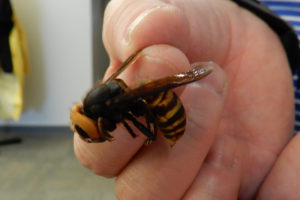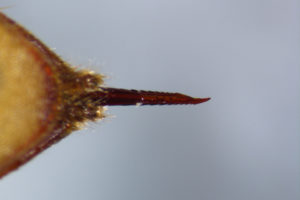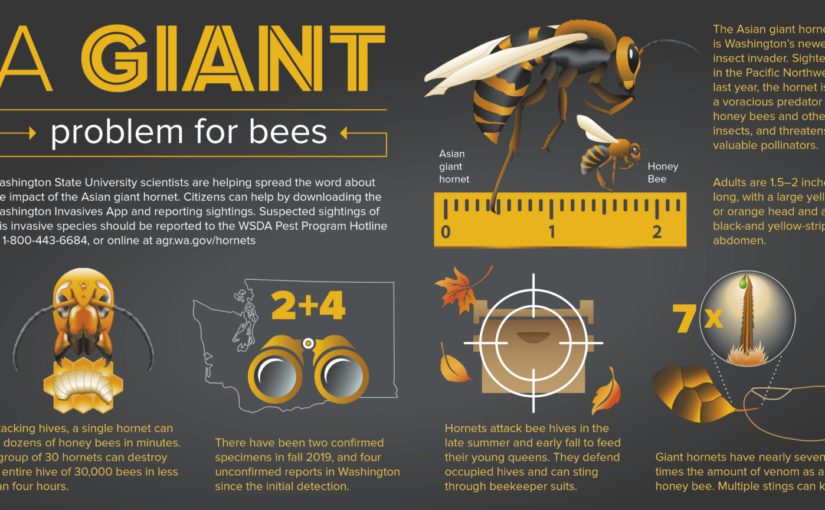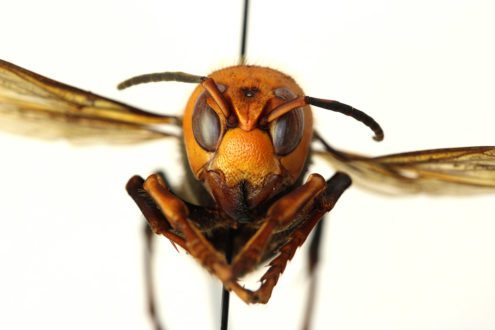May 4, 2020WSU scientists enlist citizens in hunt for giant, bee-killing hornet
More than two inches long, the world’s largest hornet carries a painful, sometimes lethal sting and an appetite for honeybees. It is also the newest insect invader of Washington state.
The Asian giant hornet, Vespa mandarinia, is unmistakable, said Susan Cobey, bee breeder with Washington State University’s (WSU) Department of Entomology.
“They’re like something out of a monster cartoon with this huge yellow-orange face,” she said.
“It’s a shockingly large hornet,” added Todd Murray, WSU Extension entomologist and invasive species specialist. “It’s a health hazard, and more importantly, a significant predator of honey bees.”


Cobey, Murray and other WSU scientists are bracing for the giant hornet’s emergence this spring. Sighted for the first time in Washington last December, the hornet will start to become active in April. WSU researchers are working with the Washington State Department of Agriculture (WSDA), beekeepers and citizens to find it, study it and help roll back its spread.
Voracious predator
In the first-ever sightings in the U.S., WSDA verified two reports of the Asian giant hornet late last year near Blaine, Wash. and received two probable, but unconfirmed reports, from sites in Custer, Wash.
It is not known how or where the hornet first arrived in North America. Insects are frequently transported in international cargo and are sometimes transported deliberately.
At home in the forests and low mountains of eastern and southeast Asia, the hornet feeds on large insects, including native wasps and bees. In Japan, it devastates the European honeybee, which has no effective defense.
Hornets are most destructive in the late summer and early fall, when they are on the hunt for sources of protein to raise next year’s queens. V. mandariniaattack honey bee hives, killing adult bees and devouring bee larvae and pupae, while aggressively defending the occupied colony. Their stings are big and painful, with a potent neurotoxin. Multiple stings can kill humans, even if they are not allergic.The Asian giant hornet’s life cycle begins in April, when queens emerge from hibernation, feed on plant sap and fruit, and look for an underground dens to build their nests. Once established, colonies grow and send out workers to find food and prey.
Forever changes
Growers depend on honeybees to pollinate many important northwest crops like apples, blueberries and cherries.
With the threat from hornets, “beekeepers may be reluctant to bring their hives here,” said Island County Extension scientist Tim Lawrence.
“As a new species entering our state, this is the first drop in the bucket,” said Murray. Once established, invasive species like the spotted wing drosophila fruit fly or the zebra mussel make “forever changes” to local crops and ecologies.
“Just like that, it’s forever different,” Murray said. “We need to teach people how to recognize and identify this hornet while populations are small, so that we can eradicate it while we still have a chance.”
Beekeepers, WSU Master Gardener volunteers and other Extension clients are often the first detectors of invasive species. WSU scientists are now spreading awareness of the hornet to citizens and developing a fact sheet to help people identify and safely encounter the insects.
As partners with the Washington Invasive Species Council, they also urge citizens to download the WA Invasives smartphone app for quick reporting of sightings.
“We need to get the word out,” said Lawrence. “We need to get a clear image of what’s happening out there, and have people report it as soon as possible.”
Early detection, faster eradication


Scientists with the WSDA Pest Program are taking the lead on finding, trapping and eradicating the pest. WSDA will begin trapping for queens this spring, with a focus on Whatcom, Skagit, San Juan, and Island counties.
“Our focus is on detection and eradication,” said WSDA entomologist Chris Looney.
The agency plans to collaborate with local beekeepers and WSU Extension scientists and entomologists with WSU focusing its efforts on management advice for beekeepers.
Regular beekeeping suits are poor protection against this hornet’s sting, said Looney. WSDA ordered special reinforced suits from China.
“Don’t try to take them out yourself if you see them,” he said. “If you get into them, run away, then call us! It is really important for us to know of every sighting, if we’re going to have any hope of eradication.”
To report an Asian Giant Hornet sighting, contact the Washington State Department of Agriculture Pest Program at 1-800-443-6684, [email protected] or online at agr.wa.gov/hornets.
For questions about protecting honey bees from hornets, contact WSU Extension scientist Tim Lawrence at (360) 639-6061 or [email protected].
Photo at top: Asian giant hornet, the world’s largest species of hornet, was found late last year in northwest Washington. WSU Extension scientists are partnering with state agencies, beekeepers, and citizens to identify and report the invasive insect (Photo courtesy WSDA).

















